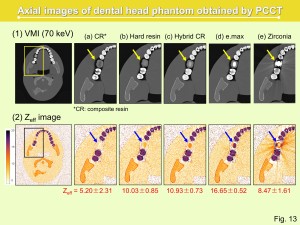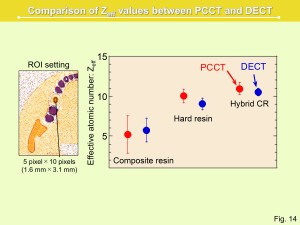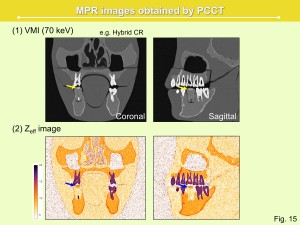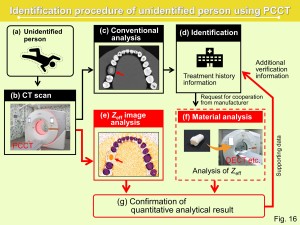Fig. 12 (a) shows the Zeff images of the multi-energy CT phantom obtained by the PCCT and DECT. The Zeff image generated by DECT has been applied a noise reduction filter recommended by the manufacturer, so the noise is relatively lower. The Zeff image obtained by PCCT is a filterless image, and it has the potential to generate an image having smaller noise by applying image processing filters. The quantitative analysis results are shown in Fig. 12 (b), and the mean and standard deviation (SD) values within the ROI are plotted. The Zeff values obtained with both scanners were in good agreement with the calculated Zeff values. The lower graphs show the residual error from the Y=X line. Based on the observed residual errors, the systematic uncertainties of Zeff images acquired by PCCT and DECT were determined to be 0.40 and 0.20, respectively.

Fig. 13 shows the results of a phantom experiment using dental inlay-materials. A dental material was implanted in the 6th tooth on the lower right. The VMIs at 70 keV are presented as the conventional images. For images without artifacts, the dental materials could be clearly discriminated in Zeff images presented in the lower row.

The Zeff images of dental materials obtained by the experiment using the dental head phantom were quantitatively compared as shown in Fig. 14. The mean Zeff values were plotted which were determined within the ROIs. The error bars of each data were determined taking into consideration the deviation within the ROI and systematic uncertainty. It was found that the results between PCCT and DECT were consistent.

Fig. 15 shows an example of a multi-planar reconstruction (MPR) image of a dental head phantom acquired by PCCT. Coronal and sagittal images of dental head phantom embedded with a hybrid CR were reconstructed for both (a) VMI and (b) Zeff images. No significant artifacts were observed in any cross-section of the Zeff images. This demonstrates that our method is applicable to the analysis of three-dimensional volume data.

Fig. 16 shows the procedure for applying our method to human identification in forensic dentistry. For diagnosing (a) unidentified human remains, we recommend to use (b) PCCT, if available. The PCCT produces (c) a conventional (qualitative) image, therefore a traditional diagnostic process can be performed. By integrating various information, (d) the identification is performed. Our proposal has the great advantage that if an unidentified person was examined by (b) PCCT, (e) Zeff analysis can later be performed if necessary. When identifying the unidentified person in step (d), the dental material used in his/her treatment can be acquired from the treatment history information. If the same dental material is obtained from the manufacturer, (f) material analysis is performed based on Zeff. The most important point of our proposal is that any equipment can be used to analyze the Zeff value in step (f). Since the Zeff value is a physical quantity specific to the object, it is possible to (g) confirm the quantitative analysis based on the information in (e) and (f) without depending on the determination procedure.
